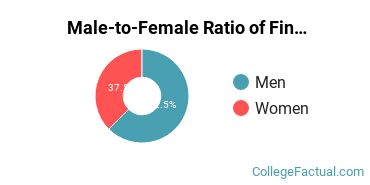 by our College Data Analytics Team
by our College Data Analytics TeamThe main focus area for this major is Finance. For more details on this concentration, visit its profile page.
Finance & Financial Management is a major offered under the business, management and marketing program of study at Linfield University - McMinnville Campus. We’ve pulled together some essential information you should know about the bachelor’s degree program in finance, including how many students graduate each year, the ethnic diversity of these students, and more.
If there’s something special you’re looking for, you can use one of the links below to find it:
Learn about start dates, transferring credits, availability of financial aid, and more by contacting the universities below.
Managing and quantifying money is at the heart of the online bachelor's degree in finance at SNHU. You'll learn the fundamentals of investments, address key managerial issues, examine ethics from every angle and build the skillset to be a player in the multidimensional business marketplace.
Invest in the analytical and quantitative skills you need to succeed in a career in finance with this online bachelor's from Southern New Hampshire University.
BS in Business Administration - Finance
Increase your potential in nearly any industrial, financial, nonprofit or government organization with this online business administration bachelor's degree from Southern New Hampshire University.
In order to help students and their parents find the best school for them, we have created several different types of college rankings, which are updated yearly. The bachelor's program at Linfield was ranked #171 on College Factual's Best Schools for finance list. It is also ranked #2 in Oregon.
Here are some of the other rankings for Linfield.
In 2019-2020, the average part-time undergraduate tuition at Linfield was $1,390 per credit hour for both in-state and out-of-state students. Information about average full-time undergraduate tuition and fees is shown in the table below.
| In State | Out of State | |
|---|---|---|
| Tuition | $44,450 | $44,450 |
| Fees | $682 | $682 |
| Books and Supplies | $1,000 | $1,000 |
| On Campus Room and Board | $12,930 | $12,930 |
| On Campus Other Expenses | $1,950 | $1,950 |
Learn more about Linfield tuition and fees.
One way to think about how much a school will cost is to look at how much in student loans that you have to take out to get your degree. Finance students who received their bachelor’s degree at Linfield took out an average of $27,000 in student loans. That is 15% higher than the national average of $23,578.

Learn about other programs related to <nil> that might interest you.
BS in Finance - Financial Planning
Whether you're looking to enter the field or change careers, SNHU's online financial planning degree can prepare you to pursue a wide range of jobs in finance, insurance, business and banking. The program is ideal for individuals with a solid mix of interpersonal and analytical skills.
finance who receive their bachelor’s degree from Linfield make an average of $53,045 a year during the early days of their career. That is 10% higher than the national average of $48,186.

Online degrees for the Linfield finance bachelor’s degree program are not available at this time. To see if the school offers distance learning options in other areas, visit the Linfield Online Learning page.
About 37.5% of the students who received their Bachelor’s in finance in 2019-2020 were women. This is higher than the nationwide number of 29.1%.

Around 25.0% of finance bachelor’s degree recipients at Linfield in 2019-2020 were awarded to racial-ethnic minorities*. This is about the same as the nationwide number of 26%.

| Race/Ethnicity | Number of Students |
|---|---|
| Asian | 0 |
| Black or African American | 0 |
| Hispanic or Latino | 1 |
| Native American or Alaska Native | 2 |
| Native Hawaiian or Pacific Islander | 0 |
| White | 10 |
| International Students | 0 |
| Other Races/Ethnicities | 3 |
Finance & Financial Management students may decide to major in one of the following focus areas.
| Focus Area | Annual Graduates |
|---|---|
| Finance | 16 |
You may also be interested in one of these majors related to finance and financial management.
| Related Major | Annual Graduates |
|---|---|
| Business Administration & Management | 27 |
| Accounting | 13 |
| International Business | 2 |
| Marketing | 20 |
*The racial-ethnic minorities count is calculated by taking the total number of students and subtracting white students, international students, and students whose race/ethnicity was unknown. This number is then divided by the total number of students at the school to obtain the racial-ethnic minorities percentage.
More about our data sources and methodologies.